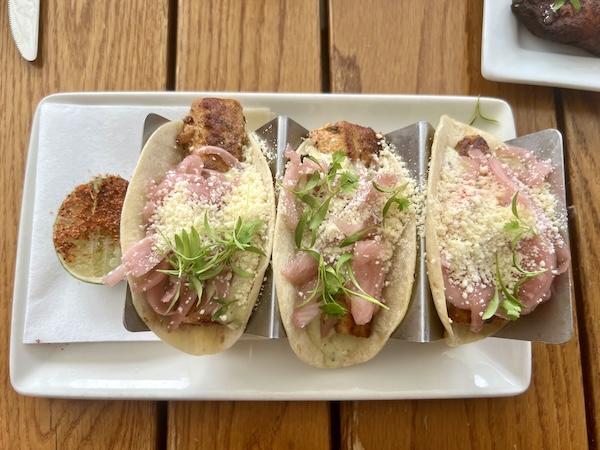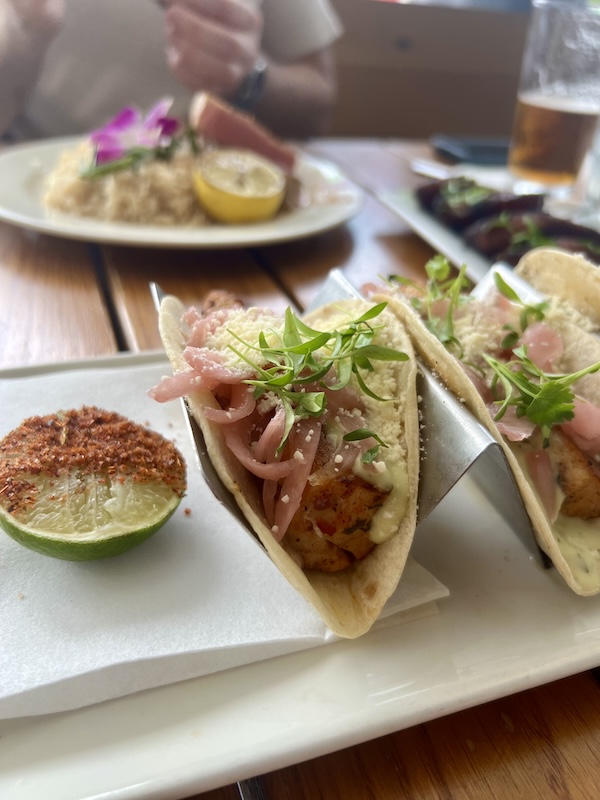Maybe it’s not an actual club, but it’s one of those places that make you feel like it were. Bayshore Club Bar & Grill is part casual with an open air bar with TVs, part elevated outdoor dining with exclusive sections and loungers. Along with the entirety of Regatta Grove, it’s branded enough to make you feel a part of something. Serving coastal fare and beautiful drinks right on the water, it’s a “club” you’ll want to be a part of.
This place has some history, too! Originally an island, Dinner Key was connected to the mainland in 1914 and was a popular picnic spot for boat travelers. In 1918, it became the first continental naval air station in the U.S. until the end of WWI. During the 1930s and 40s, it was a base for Pan American World Airways’ Clipper planes, housed in the now-restored hangars at Bayshore Club. The original Art Deco terminal is now Miami City Hall.
From the early days, Bayshore Club has been inspired by the golden age of flight, so it’s meant to offer a nostalgic experience, reminiscent of pre-flight meals. It embodies the spirit of travel and vacation, with delicious food, an impressive bar, and an atmosphere that provides a temporary escape.
But it’s not just about the vibe. The menu has some seriously impressive offerings, and they were all delicious too. Starting with one of the prettier appetizers I’ve seen in Miami, the Salmon Tiradito:

This salmon, cucumber, passion fruit, yuzu, rocoto ponzu, and crispy shallot tiradito is stunning. It’s one of the only appetizers to give the Conchita’s Oka at La Mar a run for its money. But it reminds me of La Mar in other ways as well.
Tiradito is a traditional Peruvian dish that shares similarities with Japanese sashimi and ceviche. It typically consists of thinly sliced raw fish dressed in a flavorful sauce. The origins of tiradito are a testament to the Nikkei cuisine, which is the result of Japanese immigrants adapting their culinary techniques to Peruvian ingredients. Very similar to the Asian-Peruvian Fusian I loved so much at La Mar.
The base of the dish is high-quality, thinly sliced salmon. The freshness of the salmon is paramount, providing a buttery texture and a mild, delicate flavor. Then the cucumber subtly contrasts this texture with a refreshing crunch.
Yuzu, a citrus fruit commonly used in Japanese cuisine, introduces a sharp and tangy element that complements the salmon’s richness. Its bright acidity is essential in balancing the flavors. The rocoto ponzu sauce, a fusion of Japanese and Peruvian influences, adds depth and heat to the dish. Made from rocoto peppers, known for their fruity heat, this sauce provides a spicy kick while the ponzu adds a savory umami flavor.
The secret spice is the passion fruit. It adds a tropical sweetness and a slight tartness that lifts the dish. This ingredient not only contributes to the complexity, but it adds a pop of color to the presentation. Add the edible flower and it couldn’t be a prettier dish if it tried! From the ingredients and flavors to the beautiful presentation, it’s an absolutely standout dish.

From the appetizer to a handheld menu offering: the Mahi Tacos. Blackened Mahi, soft flour tortilla, green tomatillo & avocado tartar, pickle onion, sprinkled with cotija cheese.
These massive tacos are definitely enough for a main dish (especially when paired with the delicious plantains like we did). The question of if you should get them on the other hand, I would pass. Compared to the image on the menu, something went wrong with the dish we were given. While all the ingredients were right, the way it all came together ruined the taste.
The mahi-mahi, a lean, firm white fish, is seasoned with a blend of spices and meant to be blackened. This method of cooking gives it a smoky, slightly charred flavor that enhances the natural taste of the fish while maintaining its moist, flaky texture. I am almost convinced ours were breaded and fried. While the flakiness was there, that smokiness any blackened meat has was completely missing. They also just didn’t look right.
Then the tomatillo and avocado tartar, just thrown and gooped on top. Far too large of a portion, completely overtaking the taco in a way that what is essentially a sauce, should not. While I am sure the tangy tomatillos are in there somewhere, a mountain of creamy but juice-like avocado covers the mahi and overpowers any other flavors. Dare I say, even too much cojita cheese on top of that.
Again, I don’t see that being the case in the photo on the website, making me think we truly were served a hastily prepared plate. Hopefully, this isn’t your experience as I think the dish is likely quite refreshing and tasty. I will say randomly, I loved the lime covered in Tahin, what a nice touch:

And last, but certainly not least (the tacos were obviously the least), Lime & Pepper Rare Crusted Tuna with coconut rice, scallion and soy soubise.
The tuna is crusted with a blend of lime zest and pepper and then seared. I was so impressed with the sear on this, crispy around the skin and left perfectly rare in the center. This rare sear ensures the tuna remains tender and moist with each bit. The natural, delicate flavors shine right through while the seasoning adds a zesty citrus kick and a subtle peppery heat.
And a moment for the rice, please. The coconut rice is a fragrant and slightly sweet complement to the tuna. Cooked with coconut milk, this rice is creamy, aromatic, and more rich than your typical rice, providing a tropical backdrop for the fish. Plus the portion is extremely generous, just take a look at how much is on this plate:

Providing a moat around the rice and tuna, the soy soubise. Soy soubise is a modern twist on the classic French sauce, soubise. Traditionally, soubise is made with slow-cooked onions pureed with Béchamel sauce, resulting in a creamy and slightly sweet onion sauce. This classic version is often served with meats, fish, or vegetables, adding a rich and comforting flavor. Lots of chefs today experiment with soy soubise to create fusion dishes with classic French techniques with Asian flavors.
This seems to be another small example of that. And it’s wonderful. Unlike the aforementioned avocado sauce, this is one that I would want even more of. It works wonderfully with the tuna and isn’t too strong to go against the coconut rice. Add a sprinkle of scallion and you have a zesty, crispy, rich, and exciting Tuna dish.
So while our tacos maybe didn’t come out just right, the rest of the meal was perfection. Like I said, club I could get used to becoming a part of.

